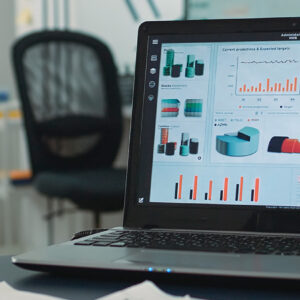Alt Text – Tips to Generate Barcodes in 2024
Generating barcodes has become essential for businesses and individuals looking to organize inventory, track sales, and streamline operations.
In 2024, barcode generation is a straightforward process, thanks to advances in technology and the availability of user-friendly barcode generator tools. These tools enable the creation of various barcode formats, such as UPC, EAN, QR codes, and more, catering to different industries and purposes.
With these factors in mind, users should look for reliable barcode generator software or online tools with a proven track record.
Essentials of Barcode Generator Technology
Barcode generator technology is integral to modern inventory management and data tracking systems. It enables quick scanning and retrieval of product information.
Defining Barcodes
Barcodes are patterns of lines and spaces that represent data by varying the widths and spacings of parallel lines or geometric patterns. These symbols can be scanned electronically to retrieve information such as product type, price, and origin.
Types of Barcodes
There are primarily two categories of barcodes: 1D (linear) and 2D (matrix).
1D barcodes include:
- UPC (Universal Product Codes): Used in retail worldwide
- EAN (European Article Number): Similar to UPC, with global scope
- Code 39, Code 128: Utilized in various industries for different applications
2D barcodes include:
- QR Codes (Quick Response): Stores a significant amount of data and commonly used in marketing
- Data Matrix: Often used in electronics and healthcare due to its small size
- PDF417: Applied in logistics and transportation for its large storage capacity
Barcoding Standards
Barcoding standards ensure that barcodes are consistent and readable across different systems and scanners. Key standards include:
- ISO/IEC: International standards covering barcode symbology and quality
- GS1: Global standards for unique product identification and supply chain management
These standards dictate barcode size, spacing, and error correction to facilitate universal readability and efficiency.
Setting Up Your Barcode Generator
Proper setup of your barcode generator is essential for efficient and accurate barcode creation. The process involves selecting appropriate software and executing a correct installation.
Choosing the Right Barcode Generator Software
Alt Text – Statistics on the growth of barcode generator software users in 2024
According to recent statistics, there has been about a 37.5% growth in the number of users of barcode generation. Several businesses opt for efficient barcode technology to enhance their authenticity and data security.
Compatibility with one’s existing systems is crucial when selecting barcode generator software. The software should support:
- Desired Barcode Types: Ensure the software can generate formats such as UPC, EAN, QR Code, or Code 128.
- Operating System Compatibility: Verify whether the software is compatible with Windows, macOS, or another operating system.
- User Interface: Look for a user-friendly interface that facilitates easy navigation and operation.
Software Installation and Setup
After choosing the software, the installation process involves:
- Downloading the Installer:
- Obtain the software installer from a trusted source.
- Verify file integrity if provided with checksums or hashes.
- Running the Installer:
- Follow on-screen instructions to install the software.
- Choose a suitable installation directory.
- Configuration:
- Configure default settings, such as output format and resolution.
- Input any required license keys or activation codes if necessary.
- Testing:
- Create test barcodes to ensure the software is functioning correctly.
- Check readability with a barcode scanner.
Creating Barcodes
The process of barcode generation involves precise data input, selecting the appropriate format, designing for optimal scanning, and thorough testing to ensure readability.
Inputting Data
Barcode creation begins with data entry. The user must input the information that the barcode will represent. This data can include anything from product numbers and serial codes to URLs. It is crucial to ensure accuracy as errors in this step can render the barcode unreadable.
Selecting Barcode Format
Barcodes come in various formats, each designed for different uses and industries. Common formats include:
- UPC: Utilized primarily in retail.
- QR Code: Offers high data capacity, ideal for marketing and information sharing.
- Code 128: Versatile and widely used for logistics and transportation.
Users must select a format compatible with their needs and scanning equipment.
Designing Barcode Aesthetics
A barcode’s design should balance aesthetics with functionality. Considerations include:
- Size: Must be large enough to be easily scanned.
- Colors: High contrast between the barcode and background is essential (e.g., black on white).
Adding company logos or branding is possible but should not interfere with scan-ability.
Generating and Testing Barcodes
After designing the barcode, the user generates it using a barcode generator tool. The generated barcode should be tested with various scanners to ensure it can be read accurately and consistently. If a barcode fails to scan properly, adjustments to the input data, format, or design may be necessary.
Barcode Generator: Best Practices
Accurate barcode generation is crucial for inventory management, sales tracking, and data retrieval. By adhering to specific best practices, organizations can ensure the reliability and efficiency of their barcode systems.
Data Management
The foundation of effective barcodes lies in organized data management. A consistent naming scheme and data structure streamline barcode creation and help eliminate errors. For optimal results, data should be:
- Structured: Group similar items logically and use consistent naming conventions.
- Predetermined formats or sequences for product numbers: (e.g., CATEGORY-SKU-ITEM).
Error Prevention
Minimizing mistakes in barcode generation protects against data mishandling and operational disruptions. Precautionary measures involve:
- System Checks: Implement checksums to automatically verify the accuracy of the barcode data.
- Utilizing barcode generation software that comes with built-in validation features.
Quality Assurance
High-quality barcodes ensure seamless scanning and operations. Quality assurance focuses on:
- Printing Standards: Mandate a minimum resolution for printed barcodes to avoid scanning issues.
- Conduct regular scans as tests to validate readability across different devices and under varied conditions.
Barcode Generator: Integration with Other Systems
Seamless integration is essential when generating barcodes to ensure compatibility and efficiency across various systems utilized within an organization.
Linking to Databases
Barcode generators in 2024 can establish direct connections to company databases. To link a barcode generator with a database, one must configure the database with the appropriate fields such as product ID, description, and price. The barcode generator then dynamically retrieves this data, ensuring that each barcode produced is accurate and up-to-date.
Incorporating with Inventory Management
Integration with inventory management systems allows for real-time tracking of stock levels. When a barcode associated with an item is scanned, the inventory management software can automatically update the item count. This integration typically involves setting up a communication protocol between the barcode generator and the inventory software to maintain consistent inventory data.
Troubleshooting Common Barcode Generator Issues
When generating barcodes, one may encounter a range of issues that can prevent them from functioning properly. This section provides targeted solutions to rectify common barcode problems that encompass scanning difficulties, printing errors, and software-related issues.
Scanning Problems
Scanning issues with barcodes often stem from improper formatting or damage to the barcode itself.
- Contrast Issues: Ensure there is sufficient contrast between the barcode and its background. A high contrast ratio, like black bars on a white background, is ideal.
- Physical Damage: If the barcode is torn, smudged, or otherwise compromised, it may not scan. Print a fresh label and replace the damaged one.
- Barcode Size: If a barcode is too small or too large, scanners may not read it accurately. Verify that the size meets the recommended specifications for your barcode type.
Printing Errors
Printing errors can occur due to hardware issues or incorrect settings.
- Printer Calibration: Regularly calibrate your printer to avoid issues like barcode stretching or misalignment.
- Resolution: Use a printer that can handle the required resolution for barcodes. Typically, a resolution of 300 DPI (dots per inch) or higher is recommended.
- Check for Ink Smearing: Ensure that the printer’s ink is not smearing during the printing process as it can distort the barcode.
Software Troubleshooting
Software problems might arise from compatibility issues or incorrect data encoding.
- Software Updates: Keep your barcode generation software updated to the latest version to prevent compatibility issues.
- Encoding Errors: Verify that the data encoded within the barcode is correct and follows the specified symbology’s rules.
- Test Scan: After generating a barcode, perform a test scan to ensure it’s readable and encodes the correct information.
Advanced Usage
In the realm of barcode generation, advanced usage encompasses both the efficient creation of barcodes in large quantities and the ability to tailor aesthetics to align with brand identities.
Batch Generation
When dealing with a large inventory, batch generation of barcodes is imperative. Users can utilize software such as Barcode Generator Pro 2024, which supports CSV or Excel file input for simultaneous barcode creation. The following steps outline the process:
- Prepare a CSV or Excel file with data for each barcode.
- Import the file into the generator.
- Specify settings like symbology and resolution.
- Execute bulk generation to produce barcodes for all items.
This method streamlines the barcode creation workflow and reduces the potential for human error.
Customization and Branding
A barcode doesn’t have to be purely functional; it can also reinforce brand identity. Modern generators allow customization options that integrate company logos, color schemes, and text. These elements can be fine-tuned:
- Logo Embedding: Inserting a logo directly within the barcode scan area or alongside the code, ensuring the brand is visible upon scanning.
- Color Schemes: Applying company colors to the bars and background, while maintaining sufficient contrast for scanner readability.
- Custom Text: Adding descriptive text or unique identifiers above or below the barcode to provide additional information at a glance.
By leveraging these customization features, businesses ensure their barcodes are not only useful, but also a cohesive part of their branding strategy.
The Future of Barcode Technology
The evolution of barcode technology is driven by the need for greater efficiency and accuracy in tracking a wide array of items. In 2024, advancements in this field are leveraging higher data capacity and integration with emerging technologies.
Enhanced Data Storage: Barcodes have transcended their traditional boundaries, now capable of storing more information due to improvements in data density. The adaptation of 2D barcodes such as QR codes has become a standard, facilitating more sophisticated applications.
Integration with IoT: Barcodes are increasingly incorporated within the Internet of Things (IoT) ecosystem. They serve as key identifiers, linking physical items to the digital world. This connectivity allows for enhanced tracking and management of resources, inventory, and much more.
Dynamic and Unique Codes: The concept of single-use or dynamic barcodes is gaining traction. Such barcodes ensure security for transactions and authenticity of products. Industries are employing these unique identifiers to combat counterfeiting and provide detailed product histories.
Smartphone Compatibility: With almost every individual owning a smartphone, barcode scanning has become more accessible. The upcoming software is being optimized for camera-based scanning, making barcode technology ubiquitous.
- Data Security: As barcodes become smarter, the emphasis on security intensifies. Encrypted barcodes are on the rise, ensuring that sensitive information is protected and only authorized devices can decipher the embedded data.
In conclusion, barcode technology is rapidly adapting to the digital age, providing solutions that are scalable, secure, and more integrated with the technology we use every day. An expansion in functionality, adaptability, and security marks the future of barcodes.
Conclusion
The barcode generator tools available in 2024 offer a quick and easy way to create barcodes for various purposes. Whether managing inventory, tracking assets, or organizing events, these tools can streamline your workflow and enhance efficiency.
By following the tips and techniques outlined in this guide, you can ensure that your barcodes are generated accurately and effectively, helping you easily achieve your goals.
If you are looking for a barcode generator that meets the unique needs of your business organization, visit Zoftware and sign up today for the best solutions.
FAQs
- How to generate a barcode quickly?
With the availability of robust and user-friendly software, you can quickly generate barcodes with the type of information you want to feed into them.
- How many numbers are required for barcode generation?
When generating a barcode, ensure that a minimum of 12 digits are present in the barcode.
- Can I use a barcode generator for free?
You can use web-based tools or platforms like Shopify to generate barcodes online without any charge. However, these tools might come with a set of limitations on the tools and features that you can avail.





